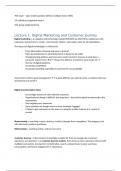70% exam – open ended question (60%) & multiple choice (40%)
5% individual assignment week 1
25% group assignment (2x)
Lecture 1: Digital Marketing and Customer Journey
Digital marketing = an adaptive and technology-enabled PROCESS by which firms collaborate with
customers and partners to create, communicate, deliver, and sustain value for all stakeholders.
The impact of digital technologies is reflected in:
- More information channels and ways to interact
- More personalization of advertising (such as based on zip code)
- Changing buying patterns and consumer needs (customer journey & what does a
consumer expect from a firm? “cheap, free delivery, involved in social issues etc.”)
- The rise of digital platforms
- Increasing competition
- Increasing marketing expenditures and need for accountability
Good metrics inform good management it is quite difficult; you need to show a company that your
investments are worth it.
Digital transformation video:
- Increasingly amount of omni-channel customers
- Organizational change is difficult, but important – they had to digital transformation the
organization
- Geo targeting very important
- Some products are bought more in store (example: luggage)
- It helps to get customers on the store, by using the mobile channel; it is a point of
contact
Showrooming = searching in store, and buy it online (cheaper from competitor). This happens a lot
with electronic products purchases.
Webrooming = searching online, and buy it in store
Customer journey = It has become increasingly complex for firms to manage the customers’
experience and journeys. In a customer journey analysis, firms focus on how customers interact with
multiple touch points, moving from consideration, search, and purchase, to post- purchase,
consumption, and future engagement or repurchase.
,Touchpoints and Channels (=place of interaction) (Herhausen et al., 2019)
Tripadvisor is a touchpoint, because you don’t interact with the hotel itself, but with a transactional
exchanger.
Types of touchpoints:
- Brand-owned touch points
- Social/external touch points
Examples:
o Owned media: website
o Paid media: online ads, at a place which is not owned by the brand; not on the
brands website: posters, on YT, Tiktok etc.
o Earned media: reviews
o Firm-initiated (FIC): comes from the firm, other kids of communication
o Customer-initated (CIC): search & referrals; comes from the consumer, they ask
for more information
A consumer going from FIC to CIC progress in their purchase decisions
process, because something triggered the consumer to look further for
information
,The zero moment of truth (ZMOT) = zero moments are the moments in between seeing the ad &
purchase. The moment were you are looking for more information, look for discounts, comparing
brands etc. This is an ongoing process, if you are not buying, the interaction is still very important for
future purchase decisions. This is a some kind of behavior, a second nature of consumers in making
decisions. Both online and offline information search. The first moment of truth is about when you
buy the product (online/offline) and after you have experienced is the second moment of truth.
There are different possible zero moments of truths: the moment you decide to buy; after seeing a
review, an Instagram ad, in store, and so on (=critical touchpoints).
Touchpoints:
- When moving through the customer journey to purchase, customers use and are
exposed to multiple touch points; each of these has direct and more indirect effects on
purchase and other customer behaviors.
- It is important to identify critical touch points (“moments of truth”) throughout the
customer journey that have the most significant influence on key customer outcomes.
- The effect of an individual touch point may depend on when it occurs in the overall
customer journey, on the type of customer, on the type of product (e.g., hedonic or
utilitarian) etc.
, Herhausen et al. (2019)
Objectives:
- Identify customer segments based on the touchpoints used in the customer journey
- Understand how the increasing importance of mobile devices affects these customer
segments
- Understand the relationships between product satisfaction, journey satisfaction,
customer inspiration, and customer loyalty vary across the different segments.
Framework:
They found 5 customer journey segments:
- Store focused segment
- Multiple touchpoint segment
- Online-to-offline segment
- Pragmatic online segment
- Extensive online segment
Amount of used touchpoints:





